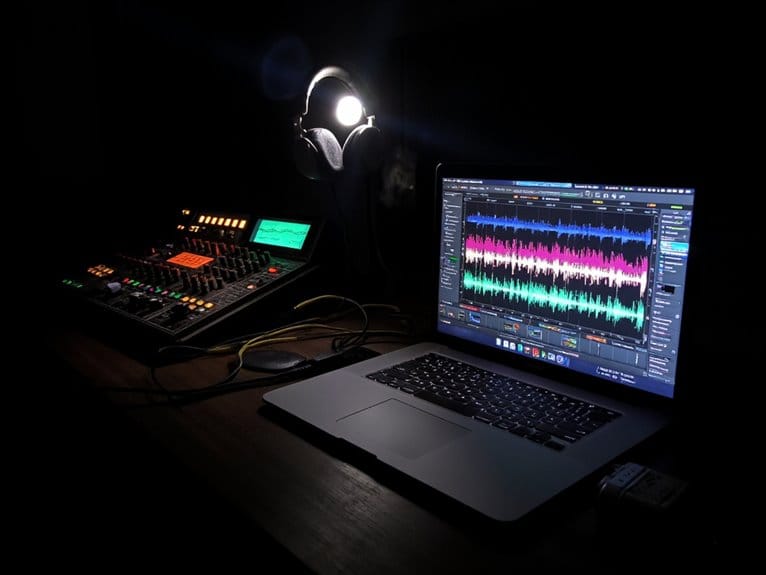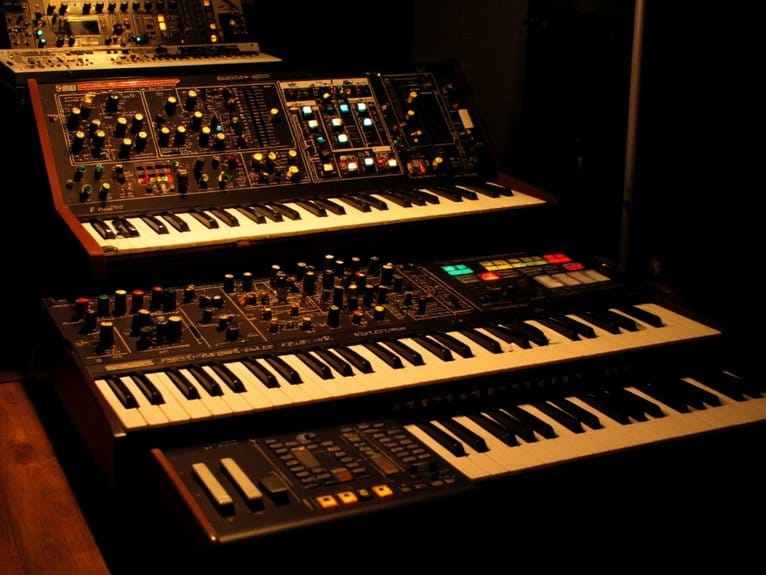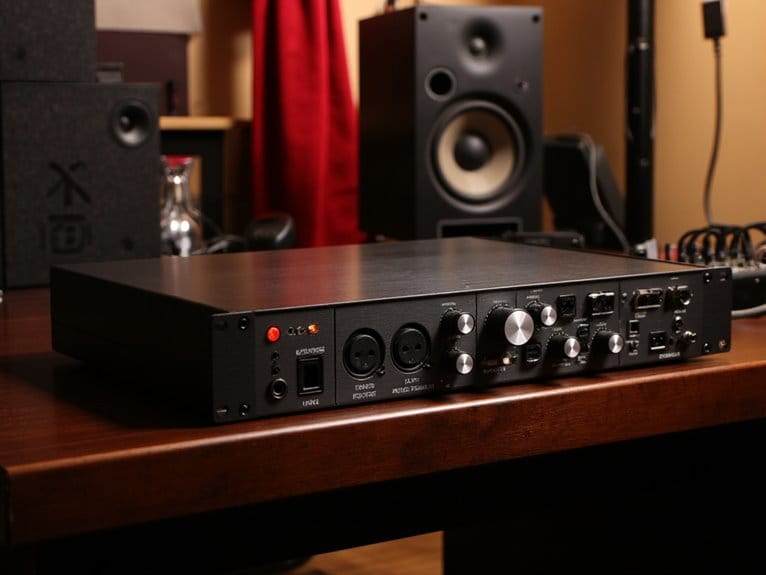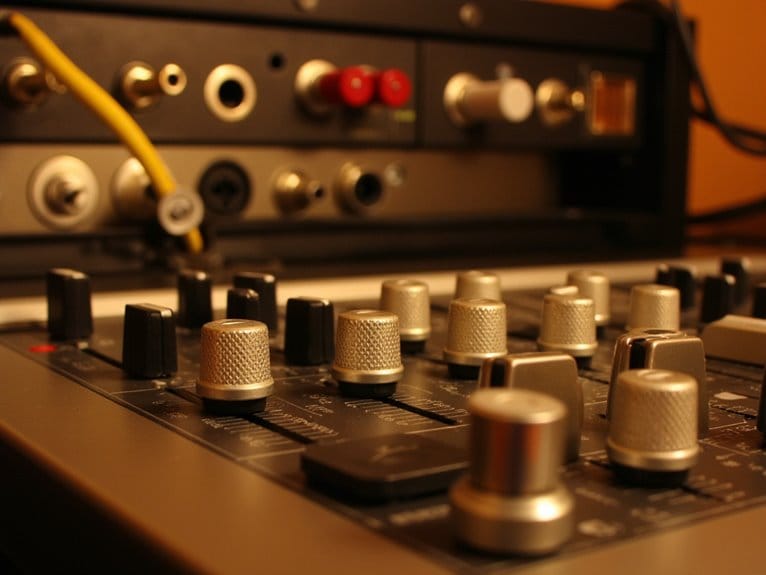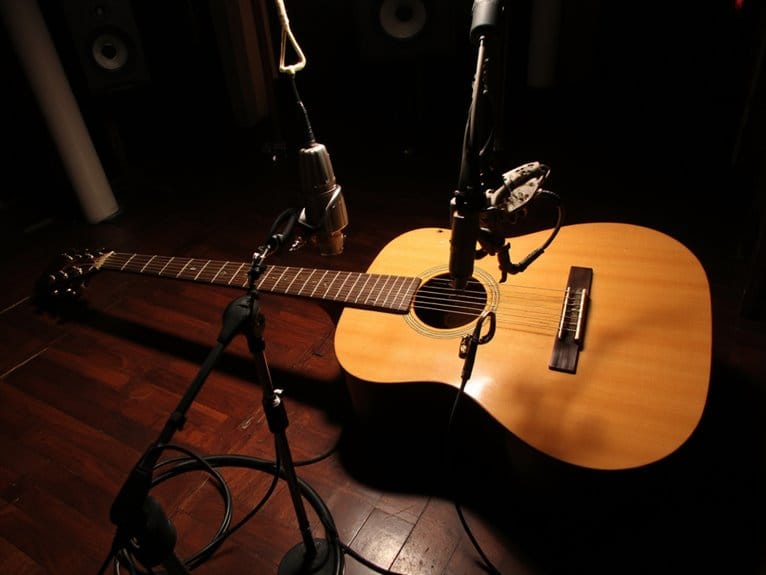Direct Monitoring Vs Software Monitoring Explained
Direct monitoring routes your input signal straight to headphones, bypassing your computer entirely for zero-latency feedback that’s essential for tight timing during recording sessions. Software monitoring sends the signal through your DAW first, introducing 3-23ms of delay depending on buffer settings, but you’ll hear real-time effects processing. You’ll want direct monitoring for initial tracking to maintain timing precision, while software monitoring works better for overdubbing with effects. Understanding buffer management and signal routing will transform your recording workflow completely.
We are supported by our audience. When you purchase through links on our site, we may earn an affiliate commission, at no extra cost for you. Learn more.
Notable Insights
- Direct Monitoring routes audio signals directly to headphones, eliminating latency but preventing real-time effects processing.
- Software Monitoring sends signals through your DAW for effects processing, which introduces latency but enables polished sound.
- Direct Monitoring provides zero-latency feedback, making it ideal for initial tracking sessions and tight synchronization requirements.
- Software Monitoring latency depends on buffer size: smaller buffers (64 samples) create lower latency but demand more CPU.
- Choose Direct Monitoring for live recording sessions and Software Monitoring for overdubbing, mixing, or virtual instrument work.
Understanding the Fundamental Differences Between Monitoring Types
Two fundamentally different approaches exist for monitoring audio during recording sessions, and I’ve found that understanding their core differences can dramatically impact your recording workflow and final results.
Direct Monitoring routes your input signal straight to your headphones or speakers, completely bypassing your computer’s processing chain, which eliminates latency but prevents you from hearing effects or plugins.
Software Monitoring, on the other hand, sends your signal through your DAW where it gets processed with all your effects and automation, allowing you to hear the polished mix but introducing some delay.
The trade-off is simple: Direct Monitoring prioritizes zero-latency performance, while Software Monitoring lets you hear your fully processed sound in real-time. This real-time feedback is especially crucial for singers who need to evaluate their vocal performance while recording. Your choice may also depend on project complexity and your computer’s processing power, as more demanding projects can strain your system’s resources.
How Direct Monitoring Works and Its Signal Path
When you connect your microphone or instrument to an audio interface, something elegant happens behind the scenes that I’ve come to appreciate after years of recording—your input signal gets intelligently split into two identical copies at the hardware level, with one copy traveling directly to your headphones or monitors while the other journeys through your computer’s USB or Thunderbolt connection to reach your DAW for recording.
| Signal Path | Processing | Latency |
|---|---|---|
| Direct Route | Hardware Only | Zero Delay |
| DAW Route | Computer Processing | Variable Delay |
| Combined | User Controllable | Adjustable Mix |
This signal splitting preserves complete signal integrity since your direct path receives an unaltered, pristine copy of your performance. Direct monitoring benefits include real-time feedback without the processing delays that plugins create, allowing you to maintain perfect timing while recording complex arrangements. Many professional audio interfaces feature a Playback/Direct mix knob that lets you balance between your live input signal and your computer’s playback, giving you ultimate control over what you hear during recording sessions. Most interfaces include control buttons or dedicated knobs specifically designed for managing your direct monitoring setup. The zero-latency monitoring feature is particularly valuable when working with low-output microphones that require high gain settings, as it eliminates the delay that would otherwise affect your performance timing.
Software Monitoring Process and Latency Considerations
When you’re using software monitoring, your input signal takes a completely different journey through your audio interface, computer processing, and back out to your headphones, creating multiple opportunities for delay that simply don’t exist with direct monitoring.
I’ve found that understanding the primary culprits behind software monitoring latency—analog-to-digital conversion, buffer processing, and digital-to-analog conversion—helps you make informed decisions about your recording setup, especially when timing precision matters most. While software monitoring introduces latency challenges, it becomes essential when you need effects processing on your monitored signals during recording or performance.
Your DAW’s buffer size setting becomes the critical balancing act here, where smaller buffers reduce that annoying delay but demand more from your CPU, while larger buffers provide stability at the cost of noticeable lag that can throw off your performance. Modern audio software systems require comprehensive testing methodologies to ensure they maintain consistent performance across different hardware configurations and processing loads.
Software Processing Signal Path
Unlike direct monitoring’s straightforward analog path, software monitoring takes your audio signal on a considerably more complex journey through multiple digital processing stages, each adding its own contribution to what we call latency.
Your audio routing begins at the interface’s analog-to-digital converter, then travels through audio drivers into your DAW, where it encounters plugin effects, signal processing algorithms, and digital mixing operations before reaching output routing destinations.
This intricate audio workflow involves multiple buffers temporarily storing data chunks while your CPU handles demanding calculations for each effect you’ve loaded. Each piece of equipment in the signal path can introduce noise and distortion if not properly managed, requiring careful attention to maintain audio quality throughout the digital processing chain.
While monitoring latency accumulates through these stages, proper performance optimization through buffer adjustments and efficient drivers can minimize delays, giving you the flexibility to process recordings with sophisticated effects that direct monitoring simply can’t match. Professional engineers often utilize a secondary audio interface specifically for monitoring to avoid latency and artifacts that can compromise critical listening decisions.
Latency Sources and Causes
The complexity behind software monitoring’s latency issues stems from multiple interconnected sources that each contribute their own delays to your audio signal chain, creating a cumulative effect that can make real-time performance challenging. Understanding these latency types helps you identify hardware challenges and implement proper driver optimization for better monitoring techniques.
| Latency Source | Impact Level |
|---|---|
| Audio Interface Drivers | High (especially Windows) |
| Buffer Processing | Medium-High |
| Plugin Processing Overhead | Variable |
| OS Thread Scheduling | Medium |
| Hardware Protocol Delays | Low-Medium |
Your system settings directly affect processing overhead, and tools like LatencyMon provide latency analysis to pinpoint problematic drivers. While optimizing these factors improves audio quality, remember that standard operating systems aren’t real-time environments, so some latency remains inevitable in software monitoring workflows. When ISRs and DPCs execute at elevated priority levels, they can interrupt audio processing threads and contribute additional delays to your monitoring chain. The analog to digital conversion process also introduces additional latency as audio signals are processed through your interface’s converters.
DAW Buffer Size Impact
Buffer size sits at the heart of your DAW’s latency equation, functioning as the primary control valve that determines how quickly audio data flows through your software monitoring chain.
When you’re tracking with software monitoring, buffer size effects become immediately apparent—smaller buffers like 64 samples deliver snappy 2.9ms round-trip latency at 44.1kHz, while larger 512-sample buffers stretch that to 23ms, creating noticeable delays that’ll throw off your timing.
Your CPU bears the computational burden of these latency adjustments, working harder with smaller buffers but rewarding you with responsive monitoring that feels natural during performance.
- Start with 64-128 samples for tracking sessions requiring tight timing
- Increase to 256+ samples during mixing when latency matters less
- Monitor CPU meters to prevent audio dropouts and system crashes
- Update drivers regularly for improved buffer handling efficiency
Real-Time Performance Benefits of Direct Monitoring
When you’re recording with direct monitoring, you’ll experience the immediate satisfaction of hearing your performance without the frustrating delay that typically plagues software-based monitoring systems.
This zero-latency feedback becomes essential when you’re trying to maintain tight synchronization with backing tracks, click tracks, or other musicians, since even milliseconds of delay can throw off your natural timing and create that disorienting “playing behind the beat” sensation.
I’ve found that eliminating these recording latency issues doesn’t just improve technical accuracy, it actually preserves the emotional flow and confidence that separates a mediocre take from a genuinely inspired performance.
Eliminating Recording Latency Issues
Recording latency becomes one of those invisible performance killers that’ll throw off your timing faster than you can say “take two,” but direct monitoring cuts through this problem by bypassing your computer’s processing entirely.
When you’re laying down tracks, those milliseconds of delay from software monitoring can accumulate into serious timing issues that’ll haunt your mix later. Smart monitoring techniques using hardware-level routing deliver zero-latency feedback, letting you hear exactly what you’re playing without that frustrating delay that makes you second-guess every note.
- Hardware routing eliminates computer processing delays that typically measure in milliseconds
- Real-time feedback prevents timing compensation errors during overdubs and punch-ins
- Latency reduction maintains authentic groove and feel of live performances
- Consistent monitoring experience regardless of DAW, plugins, or system specifications
Maintaining Synchronous Musical Performance
Although direct monitoring eliminates latency, its most profound impact hits when multiple musicians need to lock into the same pocket together, transforming what could be a frustrating guessing game into tight, coordinated performances.
When you’re recording with a band, even one millisecond of delay can throw off your internal clock, creating that uncomfortable feeling where you’re constantly fighting the track.
Direct monitoring’s synchronous techniques allow each performer to hear their instrument instantly, maintaining the natural timing that makes ensemble playing work. This performance stability becomes critical when you’re layering parts or playing alongside drum machines, where precision isn’t just preferred—it’s essential for professional results that don’t sound disjointed.
Essential Equipment and Hardware Requirements
Several vital hardware components form the foundation of any effective monitoring setup, and I’ve learned through years of studio work that skimping on these essentials will compromise your entire recording workflow.
Your essential monitoring equipment starts with a professional audio interface featuring zero-latency direct monitoring capabilities, multiple inputs/outputs, and high-quality DACs/ADCs for pristine signal conversion.
Studio monitors or reference headphones that reproduce audio without coloration become your truth-telling companions, while clean preamps feed your microphones and instruments into the system. Modern interfaces often include phantom power for condenser microphones, eliminating the need for external power supplies.
Understanding hardware connection types proves equally important—balanced XLR and TRS cables eliminate noise interference, while USB, Thunderbolt, or PCIe connections maintain stable, low-latency communication between your interface and computer.
When selecting an audio interface, prioritize devices with at least 24-bit/192kHz resolution and a dynamic range specification of 106dB or higher to ensure detailed audio capture without distortion.
- Professional audio interface with zero-latency direct monitoring and multiple I/O options
- Reference-quality studio monitors or headphones for accurate audio reproduction
- Clean preamps for microphones and instruments with high-fidelity signal processing
- Balanced cables (XLR/TRS) and high-speed digital connections (USB/Thunderbolt)
Choosing the Right Monitoring Method for Your Setup
When your signal chain finally delivers clean, balanced audio to your ears, the critical decision between direct and software monitoring determines whether you’ll capture inspired performances or struggle with timing issues that plague your entire recording session.
Your monitoring preferences should align with your hardware capabilities, recording goals, and tolerance for latency-induced performance anxiety.
Consider these factors when selecting your monitoring approach:
- System resources – Choose direct monitoring if you’re running processor-intensive sessions or using older hardware that struggles with low-latency software monitoring.
- Effects requirements – Opt for software monitoring when real-time reverb, compression, or pitch correction enhances performer confidence during tracking.
- Interface capabilities – Confirm your audio interface provides blend controls or dedicated monitoring outputs for seamless direct monitoring implementation.
- Session complexity – Simple overdubs work well with direct monitoring, while complex productions benefit from software monitoring’s flexibility.
Look for interfaces with zero-latency monitoring capabilities, which eliminate the delay between input signal and headphone output that can disrupt timing-sensitive performances.
Professional interfaces feature visual level monitoring tools that help you optimize your monitoring setup regardless of your chosen method.
Frequently Asked Questions
Can I Use Direct Monitoring With USB Microphones or Only XLR Interfaces?
You can absolutely use direct monitoring with USB microphones, though USB microphone compatibility varies considerably between models.
While audio interface options with XLR inputs typically offer more extensive monitoring controls, many USB mics include headphone jacks that provide true zero-latency direct monitoring.
Higher-end USB microphones like the Samson Q9U feature dedicated monitoring controls, whereas cheaper models often route audio through your computer, introducing unwanted latency during recording sessions.
Does Direct Monitoring Work With MIDI Instruments and Virtual Synthesizers?
Direct monitoring doesn’t work with MIDI instruments or virtual synthesizers because they don’t produce audio signals themselves, requiring software processing within your DAW.
You’ll need software monitoring for virtual instrument latency management, which I’ve found works well when you optimize buffer sizes and use low-latency DAW settings for midi performance, though it’ll never achieve the zero-latency benefits of direct monitoring.
Will Direct Monitoring Drain My Laptop Battery Faster During Mobile Recording Sessions?
Actually, direct monitoring will help preserve your laptop’s battery during mobile sessions, since it bypasses CPU processing entirely and routes audio directly through your interface.
You’ll experience considerably lower battery consumption compared to software monitoring, which taxes your processor with real-time effects and plugin processing, while maintaining excellent recording quality throughout your portable sessions.
Can I Apply Reverb or Effects While Using Direct Monitoring Features?
You can’t apply reverb applications or standard effects processing through your DAW when direct monitoring‘s active, since the signal bypasses all software entirely.
However, I’ve found workarounds like using pre-fader sends to auxiliary channels, which introduces minimal latency that’s barely noticeable with reverbs and delays.
Higher-end interfaces offer built-in hardware effects that process signals before reaching your headphones, eliminating latency completely.
Is Direct Monitoring Compatible With Wireless Headphones and Bluetooth Audio Devices?
Direct monitoring isn’t compatible with Bluetooth headphones due to wireless compatibility limitations and inherent audio latency issues.
Bluetooth introduces 100-200ms delay, which defeats direct monitoring‘s zero-latency purpose.
You’ll need wired headphones connected directly to your audio interface for true direct monitoring.
Some wireless microphone receivers offer wired headphone outputs as workarounds, but you can’t achieve genuine direct monitoring through Bluetooth or wireless connections.
On a final note
You’ll find that choosing between direct and software monitoring ultimately depends on your specific recording environment, latency tolerance, and workflow preferences. Direct monitoring excels when you’re tracking vocals or instruments where real-time feedback is essential, while software monitoring works better for complex productions requiring extensive plugin processing. I’ve learned that many professionals actually use both methods strategically, switching based on the recording phase and performance requirements of their current project.

